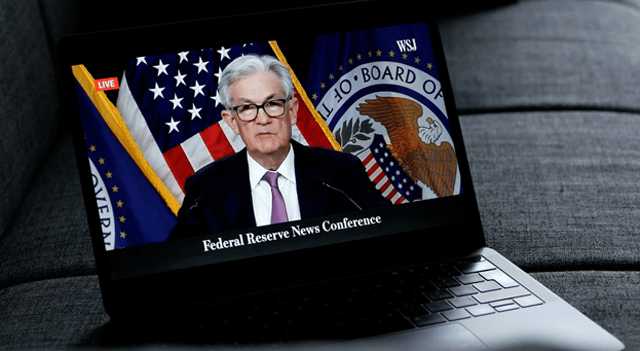U.S. stock index futures edged lower on Tuesday as investors awaited a heavy slate of earnings from major Wall Street banks and a closely watched speech from Federal Reserve Chair Jerome Powell. The cautious tone comes amid rising U.S.–China trade tensions, fresh gains in gold prices, and a pullback in oil.
Futures Weaken as Risk Sentiment Shifts
Futures for U.S. equity benchmarks traded in the red early Tuesday. By 03:01 ET, S&P 500 futures were down 47 points (−0.7%), Nasdaq 100 futures slipped 230 points (−0.9%), and Dow futures dropped 197 points (−0.4%).
The market’s retreat follows a strong rebound on Monday, when stocks recovered most of their recent losses after President Donald Trump appeared to soften his stance on tariffs against China. His previous threat to hike duties on Chinese goods had triggered last week’s sell-off, but comments suggesting a more conciliatory approach helped calm investors.
U.S. Treasury Secretary Scott Bessent reinforced the more positive tone, confirming that the expected meeting between Trump and Chinese President Xi Jinping later this month in South Korea “remains on track,” boosting hopes that trade tensions may ease.
In early movers, Broadcom Inc. (NASDAQ:AVGO) jumped more than 9% after OpenAI unveiled a deal to secure up to 10 gigawatts of AI chips from the semiconductor group. The announcement intensified investor enthusiasm around artificial intelligence stocks.
Focus Turns to Wall Street Bank Results
Earnings season kicks into gear this week with results from some of the biggest U.S. banks.
Before the opening bell, JPMorgan Chase & Co. (NYSE:JPM) will publish quarterly earnings, followed by Wells Fargo & Company (NYSE:WFC), Goldman Sachs Group, Inc. (NYSE:GS) and Citigroup Inc. (NYSE:C). Bank of America Corporation (NYSE:BAC) and Morgan Stanley (NYSE:MS) will report on Wednesday.
Analysts expect solid earnings across the sector, supported by a resilient U.S. economy that continues to drive loan demand. M&A activity has also gained momentum after earlier stagnation tied to trade policy uncertainty.
Investors will pay close attention to forward-looking commentary, particularly after JPMorgan CEO Jamie Dimon cautioned about a potential market correction “within the next six months to two years,” pointing to geopolitical uncertainty, fiscal challenges, and rising global military spending.
Powell Speech Could Steer Policy Expectations
Fed Chair Jerome Powell will address the annual gathering of the National Association for Business Economics on Tuesday.
Powell is expected to “lament” the lack of key economic data stemming from the ongoing U.S. government shutdown, analysts at Vital Knowledge noted. The data gap has complicated the Fed’s efforts to assess economic conditions, with only September CPI data expected to be released after some furloughed staff were recalled.
According to CME FedWatch Tool, markets are pricing in a 25-basis-point rate cut at the upcoming Fed meeting on October 28–29. The central bank cut rates by the same amount in September, restarting an easing cycle to address slowing employment and growth risks.
Despite pressure, there are no signs the government shutdown is close to resolution, even as the Senate reconvenes today.
Gold Surges to New Record
Gold extended its record-breaking rally, climbing past $4,100 per ounce amid renewed trade concerns and growing expectations of lower interest rates. Spot gold was up 0.4% at $4,125.35 per ounce at 03:41 ET, while U.S. futures inched 0.1% higher to $4,138.40.
The metal has risen more than 50% this year, with strong central bank purchases, ETF inflows, and macroeconomic uncertainty all contributing to demand for safe-haven assets.
Oil Slides as Trade Flare-Up Dampens Demand Outlook
Crude prices declined as traders reassessed demand prospects in the face of escalating U.S.–China trade frictions. Brent crude slipped 1.8% to $62.21 a barrel by 03:47 ET, while West Texas Intermediate fell 1.8% to $58.43.
The pullback came after China imposed sanctions on five U.S.-linked subsidiaries of Hanwha Ocean Co., Ltd. and both sides introduced additional port fees affecting shipping firms, many of which transport oil.
Investors are also awaiting the International Energy Agency’s latest monthly oil report, expected later in the day, which should offer further clarity on global supply and demand dynamics.
This content is for informational purposes only and does not constitute financial, investment, or other professional advice. It should not be considered a recommendation to buy or sell any securities or financial instruments. All investments involve risk, including the potential loss of principal. Past performance is not indicative of future results. You should conduct your own research and consult with a qualified financial advisor before making any investment decisions.
Some portions of this content may have been generated or assisted by artificial intelligence (AI) tools and been reviewed for accuracy and quality by our editorial team.
